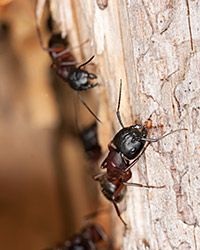 “Carpenter ants are just one of the infestations you may find in your home.iStockphoto/Thinkstock
“Carpenter ants are just one of the infestations you may find in your home.iStockphoto/Thinkstock
You may think you know everything that’s going on in your home, from your son’s crush on the neighbor girl to your daughter’s cheerleading team drama, but you may be missing a huge, thriving community that’s sharing your space: an insect infestation. Whether it’s teeny tiny bedbugs making their home in your linens or drilling carpenter ants feasting on moist wood behind your walls, these infestations can result in problems far bigger than who’s taking whom to the spring dance or which cheerleader ends up at the top of the pyramid.
Contents
- Bed Bugs
- Termites
- Stink Bugs
- Carpenter Ants
Bed Bugs
By the time you notice or properly identify bed-bug bites on your skin, the bugs may have already set up a thriving community. In earlier stages of infestation, more reliable signs of bed bugs – beyond the bugs themselves – include tiny dark spots on your sheets or mattress, white eggs or shells, empty bed bug skins, or small red marks left on your bedding by dead bugs. You can also build your own bed bug detector for about $15.
Termites
If you’re buying a new home, then a termite inspection is a worthwhile investment that makes sure you aren’t sharing your new place with wood-boring insects. An annual professional inspection can help ensure that they don’t find their way in, but if you’d rather check for them yourself, look for early-spring swarms, termites in your backyard spider webs, or small tubes around your home’s foundation. (Not sure if you have flying ants or termites? Check their wings and body shape.)
Stink Bugs
The Brown Marmorated Stink Bug is an invasive species first found in the state of Pennsylvania in the late 1990s, but has been slowly and steadily making its way across the country – with rapid reproduction habits that, combined with the bugs’ lack of a natural predator, are allowing its population numbers to skyrocket. Though you may find them in your home in the spring and fall, they aren’t dangerous – they just give off an unpleasant smell when killed or bothered. To help keep them out, secure windows and gaps in your exterior, and make sure any air vents have screens over them.
Carpenter Ants
As with many infestations, your first sign of carpenter ant problems often will be seeing the carpenter ants themselves. But when a colony needs food, it will send some of its workers far and wide to find it – so seeing the insect doesn’t mean there’s a nest. Carpenter ants prefer to nest in moist wood and they leave behind wood shavings after they drill into the lumber to make their homes, so keep a close eye on rotting wood for signs of these mini lumberjacks.
Lots More Information
More Great Links
- 10 Ways to Bug-Proof Your Home
- Benefits of Eating Bugs
- Insects and Arachnids
Sources
- “Bed Bug Information.” U.S. Environmental Protection Agency. (June 14, 2013) http://www.epa.gov/bedbugs/#identify https://blogs.howstuffworks.com/2010/01/13/how-to-detect-bed-bugs/
- “What Are Bedbugs?” Animal Planet. (June 14, 2013) http://animal.discovery.com/insects/bed-bug.htm
- “Do You Have Flying Ants or Termites?” Mother Nature Network. (June 17, 2013) http://www.mnn.com/your-home/at-home/stories/do-you-have-flying-ants-or-termites
- “Keeping Termites Away from Your Home.” TLC (June 14, 2013) https://tlc.howstuffworks.com/home/keeping-termites-away-from-your-home.htm
- “How to Tell if You Have Termites.” TLC (June 14, 2013) http://tlc.howstuffworks.com/home/how-to-tell-if-you-have-termites1.htm
- “Carpenter Ant Infestation.” Orkin. (June 18, 2013) http://www.orkin.com/ants/carpenter-ant/carpenter-ant-infestation/
- “How to Get Rid of Stink Bugs.” Mother Nature Network. (June 19, 2013) http://www.mnn.com/your-home/at-home/stories/how-to-get-rid-of-stink-bugs



























